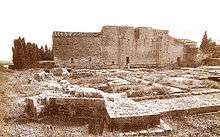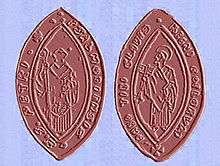Psalmody Abbey

Psalmody Abbey, also Psalmodie Abbey or Psalmodi Abbey (French: Abbaye de Psalmody, Psalmodi or Psalmodie), was a Benedictine abbey located near Saint-Laurent-d'Aigouze in the Camargue, in the department of Gard and the region of Languedoc-Roussillon in the south of France.[1][2]
History
Psalmody Abbey was founded in the 5th century by monks from the Abbey of St. Victor, Marseille. The purpose was perhaps to enjoy a favorable location for the installation of fisheries on the Rhone and saline in the marshes of delta1. The monks built on a small hill overlooking the surrounding marshes.
The new monastery acquired considerable importance and became directly accountable to Rome. Its influence grew throughout the region, mostly because of its trade in salt. The Abbey enjoyed the favor of successive emperors in 816, Louis the Pious granted protection, and in 851, Charles the Bald granted him certain privileges. To all this is added the act of 791, whereby Charlemagne confirmed the possessions of the abbey; although the charter is false and fabricated at the end of the tenth century or the next century, it is considered authentic at that time and therefore increases the prestige of the abbaye.[3]
In 908, the monks fled the abbey in face of Saracen raids. From the beginning of the 10th century, salt marshes belonging to the monks are signalés [4]whose production is marketed by river from the two small ports of the abbey, Notre Dame des Ports and Counc-Haute.[5]
Late Middle Ages
In 1004, an assembly of monks, clerics and knights took place and decided the reconstruction of the abbey, at the same time it receives its first possession overseas, Rhône.[6]
From 1052 to 1096, the abbey lost its autonomy and is directed by the Holy Victor5 abbey. She took a considerable importance to depend directly on Rome. [Ref. needed] His monks did radiate throughout the region, including through the salt trade. Abbey flourished in the twelfth century. In 1248, it sold its harbor of Our Lady of Ports on Agual Death to the King of France, Saint-Louis, who built Aigues-Mortes.[7]
It reached its peak in the 12th century. From the 15th century, the abbey declined. It was secularised in the 16th century by a bull of Pope Paul III and the buildings were largely destroyed during the war of the Camisards by Catinat, although its revenues continued to be drawn by commendatory abbots until the French Revolution.
Early Modern Times
In 1537, the abbey was secularized, the monks took refuge in the college Our Lady of Salvat. The greater part of his property was given to local bishoprics.[8] Abandoned, she gradually fell in ruins before being burned in 1701 during the War of the Camisards by Catinat.
Modern Times
Under the French Revolution, the Abbey was dissolved and its goods declared national property and sold. Today only a few scattered ruins survive.[9] The site was declared a monument historique in 1984.
List of abbots
- 762-815 : Corbilien
- 815-840 : Théodemir
- 840-886 : Thibaud
- 886-909 : Witard I
- 909-9?? : Raimbaud
- 993-99? :Ganier[10]
- 9??-997 : Bermond
- 997-1004 : Witard II
- 1004-1054 : Warnier
- 1054-1071 : Raymond I
- 1071-1076 : Guillaume I Philaud
- 1076-1082 : Bérenger
- 1082-1084 : Arnaud I
- 1084-1085 : Pierre I
- 1085-1086 : Guillaume II
- 1086-1097 : Arnaud II
- 1097-1115 : Foulques I
- 1115-1117 : Pierre II
- 1117-1141 : Bertrand
- 1141-1155 : Pierre III
- 1155-1174 : Guillaume III
- 1174-1180 : Pierre IV d’Uzès
- 1180-1185 : Guillaume IV
- 1185-1190 : Foulques II
- 1190-1198 : Guillaume V
- 1198-1203 : Aldebert
- 1203-1203 : Raymond II
- 1203-1220 : Bernard I de Génerac
- 1220-1226 : Raymond III
- 1226-1243 : Pons
- 1243-1248 : Guillaume VI
- 1248-1249 : Raymond IV
- 1249-1257 : Guillaume VII Catel
- 1257-1272 : Géraud de Bruguières
- 1272-1275 : Bernard II de Nages
- 1275-1316 : Pierre V

- 1316-1317 : Pierre VI Bedos
- 1317-1319 : Raymond V Bernard
- 1319-1320 : Arnaud III
- 1320-1330 : Frédol
- 1330-1332 : Gaillard
- 1332-1352 : Raymond VI de Sérignac
- 1352-1362 : Gaucelme de Déaux
- 1362-1364 : Raymond VII
- 1364-1368 : Guillaume VIII Columbi
- 1368-1401 : Pierre VII de Lascarri
- 1401-1415 : Aymeric des Gardies
- 1415-1438 : Arnaud IV de Saint-Félix (1)
- 1438-1439 : Pierre VIII de Narbonne de Talairan
- 1439-1462 : Arnaud IV de Saint-Félix (2)
- 1462-1484 : Guillaume IX de Saint-Félix
- 1484-1508 : Guy Lauret
- 1508-1511 : Jacques Fournier de Beaune-Semblançay
- 1511-1523 : Martin Fournier de Beaune-Semblançay
- 1523-1529 : Jérôme de Canosse
- 1529-1532 : Louis I de Canosse
- 1532-1536 : Renaud de Marigny
- 1536-1540 : Jean I de Luxembourg-Brienne
- 1540-1571 : Barnabé de Fayolles
- 1571-1590 : François I de Fayolles
- 1590-1606 : Jean II de Fayolles
- 1606-1618 : Marc de Calvière de Saint-Césaire
- 1618-1632 : Jean III de Calvière de Saint-Césaire
- 1632-1646 : François II de Calvière de Saint-Césaire
- 1646-1656 : Antoine de Calvière de Saint-Césaire
- 1656-1690 : Louis II de Calvière de Saint-Césaire
- 1690-1712 : François III Chevalier de Saulx
- 1713-1719 : Louis III François-Gabriel de Hénin-Liétard
- 1719-1744 : Charles de Bannes d’Avejan
- 1744-1755 : Louis IV François de Vivet de Montclus
- 1755-1776 : Jean-Louis du Buisson de Beauteville
- 1776-1784 : Pierre IX Marie-Madeleine Cortois de Barbe
- 1784-1791 : Cardinal Louis V François de Bausset-Roquefort
Source: Gallia Christiana
Notes and references
- ↑ Jean-Paul Clébert, Guide de la Provence mystérieuse, (Éd. Tchou, Paris, 1972).
- ↑ Cédric Bonato, Aux origines de Psalmodie, Aix-en-Provence, (Université d'Aix-Marseille (mémoire de maîtrise), 2001)
- ↑ Christiane Boekholt, « Les prieurés de Psalmody en Provence », Chroniques de Haute-Provence, Revue de la Société scientifique et littéraire des Alpes-de-Haute-Provence, 2012, n° 369, 132e année, p.74
- ↑ Christiane Boekholt, « Les prieurés de Psalmody en Provence », Chroniques de Haute-Provence, Revue de la Société scientifique et littéraire des Alpes-de-Haute-Provence, 2012, n° 369, 132e année, p.74
- ↑ Patricia Payn-Echalier, « Entre fleuve et mer, le port d'Arles et le delta du Rhône (XVIe-XVIIIe siècle) [archive] », Rives méditerranéennes 1/2010 (n° 35), p. 29-44.
- ↑ Christiane Boekholt, « Les prieurés de Psalmody en Provence », Chroniques de Haute-Provence, Revue de la Société scientifique et littéraire des Alpes-de-Haute-Provence, 2012, n° 369, 132e année, p.74
- ↑ Patricia Payn-Echalier, « Entre fleuve et mer, le port d'Arles et le delta du Rhône (XVIe-XVIIIe siècle) [archive] », Rives méditerranéennes 1/2010 (n° 35), p. 29-44.
- ↑ Christiane Boekholt, « Les prieurés de Psalmody en Provence », Chroniques de Haute-Provence, Revue de la Société scientifique et littéraire des Alpes-de-Haute-Provence, 2012, n° 369, 132e année, p.83.
- ↑ Encyclopédie-universelle.com: photograph of the ruins of Psalmody Abbey
- ↑ De Manteyer Georges, pp. 101-102, doc. n. LXXXVIII.
Sources and external links
- Clébert, Jean-Paul, 1972: Guide de la Provence mystérieuse. Paris: Éd. Tchou
- Nimausensis.com: history of Psalmody Abbey (French)
Coordinates: 43°38′07″N 4°11′46″E / 43.63528°N 4.19611°E